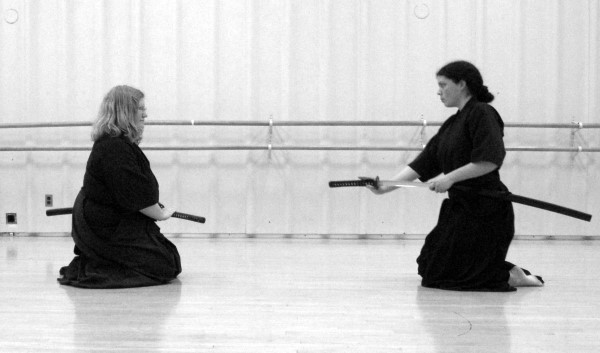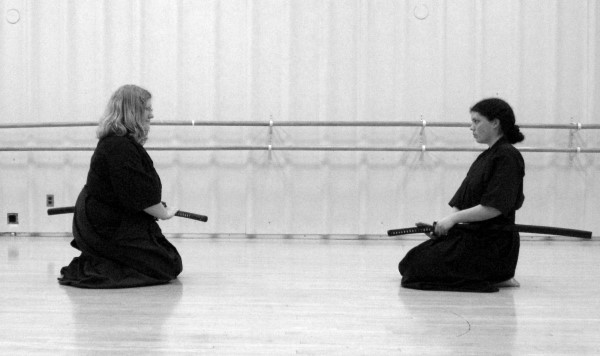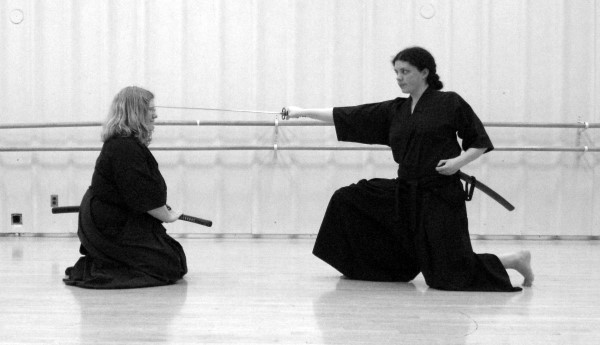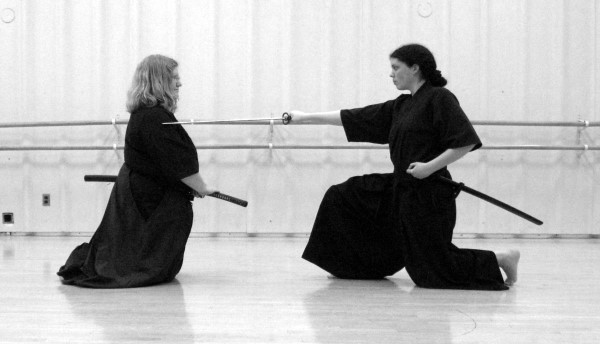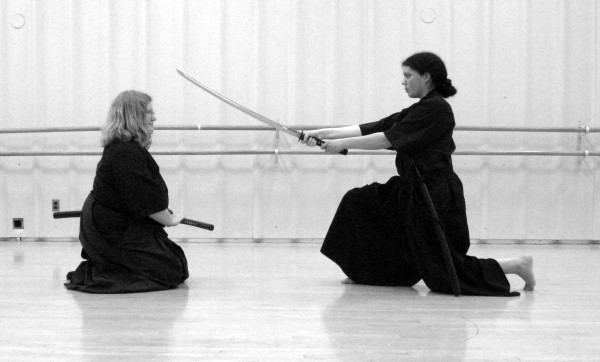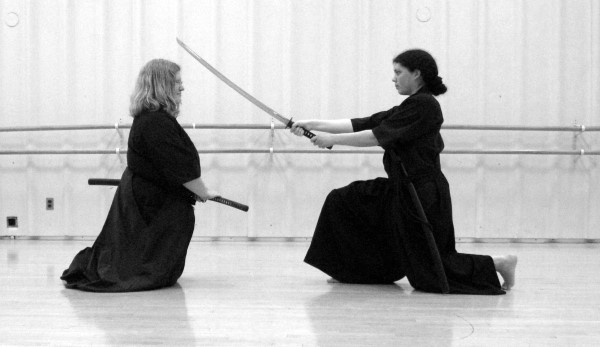Maai as a Way of Separating Koryu and Seitei
copyright ©
2010 Kim Taylor, all
rights reserved
First let me quickly say that I don't have an overall point about
distance within koryu or seitei forms. What follows is simply a way to
look at a difference between a kata done in a koryu and in a seitei set
of techniques in order to understand how to look at maai in a kata.
Distance
is often a problem in iaido but it can also be a problem in a partner
practice such as jodo. We will examine two jodo kata, one from the
koryu (Shindo Muso Ryu) and one from the ZenKenRen jo (seitei) set. We
will then look at another pair of kata from Muso Jikiden Eishin Ryu and
from the ZenKenRen iai (seitei) set. Distance is pretty easy to see in
a partner practice, but it exists in the solo practice of iaido as
well, as we shall see.
Jodo Seigan
The jodo
kata Seigan is the final kata in the Chudan set of the Shindo Muso Ryu
and it is the tenth kata of the ZKR jo. The sword approaches the jo
with the blade in the belt (saya). Jo takes the initiative and forces
sword to stop by shoving the jo into his face, then locking his right
wrist down as sword grasps the hilt. As sword tries to disengage under
the jo to draw the blade, jo reverses his weapon and thrusts into the
short ribs of sword to force him back. Sword manages to draw the sword
and takes a swing at jo's forward hand. Jo avoids and reverses the
stick once more to strike down onto sword's head (koryu) or solar
plexus (seitei).
In the Kendo Federation schools, the seitei
is usually practiced first and sword often has a problem with being too
close to do the cut to the hand. The usual instruction is for the jo to
be told to thrust more aggressively to encourage sword to move back
further. Similarly, jo is often too close after the avoidance of the
cut to the hand, and he is often told to move back more fully as sword
cuts.
Students often have a problem with these instructions as
they don't seem to make sense intrinsically, why should one step and
cut if the target is in range? Once the student has studied Seigan from
the koryu, a possible answer presents itself in the form of a simple
difference in maai, a choice point that is based on a difference in
distance which happens when the sword disengages to draw the sword. If
the sword is very aggressive he may only withdraw as far as is needed
to avoid being struck with the jo, and then counterstrike very quickly.
If the sword wishes a bit more space to move and breath, he may
withdraw further than is strictly necessary in order to better assess
the situation. Depending on this initial separation by sword, jo will
be best served by one form of the kata or another.
Here are some photographs to illustrate the point.
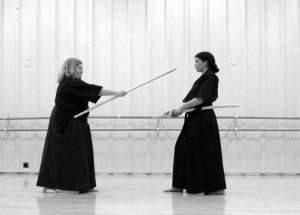
Jo interrupts sword as she walks forward by thrusting into her face. |

Then locks the jo down on the right wrist. |
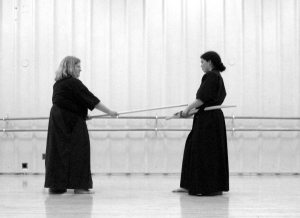
Sword responds by dropping the hilt under the jo and drawing while turning away to the right. |
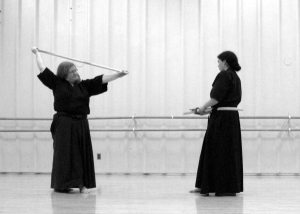
Jo responds by reversing the stick and thrusting at sword to encourage her to step back.
This is the end of the common movements. |
|

Koryu: Here sword has stepped back just far enough to avoid being hit with the stick |
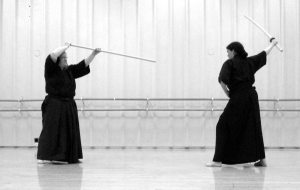
Seitei: In this case, sword has chosen to move back further as she avoids the stick. |
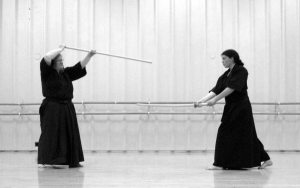
As you can see here, sword is out of range to cut back at jo. |
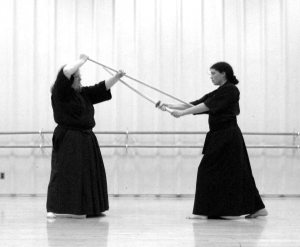
We can see that at this distance sword can strike jo on the forearm. |

As sword strikes for the forearm, jo removes her hand and slides her hands to the other end of the jo. |
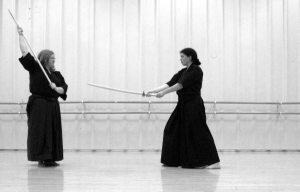
As the sword steps back in with the right foot, jo avoids the cut. |
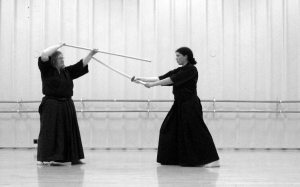
If sword steps back in, she can hit jo's forearm.
|
|
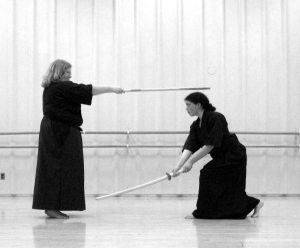
After the avoidance, jo is at a good distance to strike sword on the head from this foot together position. |

Jo now steps back in to strike sword, who is a bit further away. |
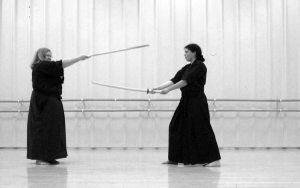
If jo tries to do the strike on the head with her feet together, sword is out of range. |
It
is often said that the seitei form of Seigan is done because the koryu
version is too dangerous. I tend to agree that the koryu form may be
dangerous for beginners, but why the extra stepping? It would be as
easy to simply drop the target from the head to the chest would it not?
Actually the chest is an awkward target if the distance is too close,
as most jodo students have found. The longer maai in the seitei version
of the kata makes the chest a good target.
Once again, in this
partner practice it is easy to see the maai, and how it affects the
kata, or rather, how the kata movements themselves determine what the
maai should be. If we are told to step in and attack, the maai must be
such that we need to step in to attack the target correctly. If we have
to do strange stutter steps to avoid cutting someone behind our
partner, we are likely not at the proper maai.
Iaido Mae
Let's move on to iaido where it is sometimes hard to
understand what is happening since we have no partner. One of the
common differences between Muso Jikiden Eishin Ryu and ZKRiai mae is
that the koryu version is "more square". We may be told that this is a
result of the different targets, with koryu cutting across our
imaginary opponent's chest (and thus a wider, more square finish
position for nuki tsuke, the first strike). In Seitei we are cutting
across the face, which means that we finish our strike with the tip of
the blade in front of our right shoulder, thus the chest is angled more
toward the left than for koryu.
Let's use this to look at
another "difference" between seitei and koryu, the slide forward in
seitei vs. the shorter movement in the koryu. If you don't know what
I'm talking about here, there are many videos available online which
will show these two kata. One convenient place would be
http://sdksupplies.com/cat_video_download.html
Why
do we slide forward in Seitei Mae and not in Koryu Mae? Let's look at
the pictures while we remember that for both versions, the initial
horizontal cut is done at the same height.
So we
see that even though there is no partner to work with in iaido, the
kata still inform us about maai. Our imaginary attacker (teki) must be
in certain positions and at a certain distance for our kata to "work".
I
hope these two simple examples of how to think about the effects of
maai in pairs of kata will stimulate more thought about your own
practice.
Thanks to Liz and Pam for taking some time out of their practice to model for these photographs.
Kim
Taylor is a nanadan (7dan) in the Canadian Kendo Federation iaido
section. He is available for seminars in iaido, jodo and niten ichiryu.
http://seidokai.ca/














